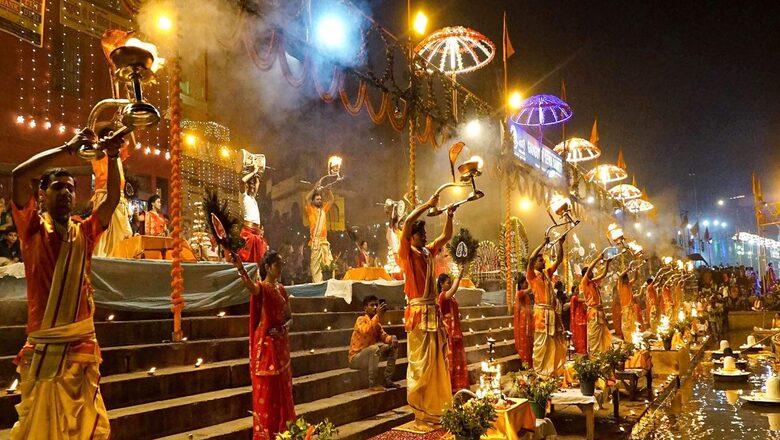
views
Bharat has been the spiritual capital of the world for times immemorial. For millennia, India’s spiritual prowess has drawn people from across the length and breadth of the planet. Some came with the intention of learning, transforming and liberating themselves, while others, like the Mughals, came to destroy India’s spiritual and civilisational soul. The realisation of the Ram Mandir dream stands as a testament to the fact that Indian civilisation has withstood repeated onslaughts and emerged stronger each time, which is why it is the only ancient spiritual civilisation of the world still in existence.
Indians are a special people, which is why spiritual and religious tourism accounts for more than 60 per cent of the country’s entire tourism industry. Last year alone, the spiritual tourism segment in India grew by 35-40 per cent year-on-year.
Ayodhya has emerged as a symbol of Bharat’s civilisational resurgence, and Bhagwan Shri Ram’s town is drawing more interest on the internet than even recreational hubs like Goa and Nainital. CEO of OYO, Ritesh Agarwal has revealed that the hospitality chain recorded an 80 per cent increase in app users in Ayodhya, surpassing Goa (50 per cent) and Nainital (60 per cent).
MakeMyTrip’s co-founder and group CEO, Rajesh Magow, has separately revealed that there is a five-fold surge in searches year-on-year and a four-fold rise in bookings as compared to last year for Ayodhya.
In fact, data from 2022 shows that recreational tourism is miles behind spiritual tourism in India. In 2022, close to 7.2 crore people visited Varanasi, 6 crore travelled to Mathura and 2.6 crore to Ayodhya. On the other hand, Goa was able to attract merely 85 lakh tourists. The difference is vast, one which puts India’s tourism scene in perspective. Spirituality trumps recreation in Bharat on any given day.
What’s more, spiritual tourism is not just limited to older Indians. In fact, travel companies say ‘spiritual tourism’ is gaining tremendous traction among young couples, millennials and Gen-Z too. OYO’s 2023 booking data shows that Puri secured the top spot as India’s most booked spiritual destination, followed by Amritsar, Varanasi, and Haridwar.
There is a renewed enthusiasm among Indians to visit spiritual centres of the country after the Covid-19 pandemic. The number of domestic tourists that visited places of pilgrimage was 1,433 million in 2022. About 6.64 million foreign tourists came to India to visit spiritual hubs in the same year. This represented a 60 per cent rise from 2021 when the numbers stood at 677 million for domestic pilgrims and 1.05 million for foreigners. Prahlad Krishnamurthi of Cleartrip told Moneycontrol that the growth of spiritual tourism as a segment has been noteworthy, particularly in the post-pandemic era, with a significant increase of 62 per cent in bookings.
According to data released by the Ministry of Tourism, pilgrimage tourism earned Rs 1,34,543 crore in 2022, as compared to Rs 65,070 crore in 2021. Tourism experts say that last year, 70 per cent of Indian travellers showed interest in spiritual getaways which include meditation and mindfulness. The spiritual tourism market last year stood at around $56 billion, rising significantly from $44 billion in 2020.
Determined ‘Spiritual’ Push by Modi Government Bearing Fruit
It is no secret that the Modi government has directed significant focus towards empowering India’s temple towns and spiritual hubs. Whether it be improving connectivity by making new airports, railway stations and roads or giving the urban infrastructure a major facelift – the Centre is working on mission mode to draw more people to spiritual and dharmic centres. It is learnt that revamping centres of spirituality was among the top priorities of Prime Minister Modi as soon as he assumed office in 2014.
The Char Dham project in Devbhoomi Uttarakhand has proven to be a game changer. The nearly 900-km project was launched by the Centre with the goal of improving connectivity to the Char Dham pilgrimage centres of Badrinath, Kedarnath, Gangotri and Yamunotri in the Himalayas. Due to improved connectivity in the region, in 2019, the Char Dham pilgrimage was made by 34 lakh people. The number went up to 35.2 lakh visitors in 2022, before shooting up to 56.1 lakh last year.
The Modi government has rolled out a dedicated scheme, called Pilgrimage Rejuvenation and Spiritual Heritage Augmentation Drive (PRASAD) to shore up visitor numbers in India’s spiritual hubs. Under the PRASAD scheme, 41 religious sites were identified from across 25 states for development.
The revamped Kashi Vishwanath Corridor, which was one of Prime Minister Modi’s pet projects, has attracted over 100 million visitors since 2021. Before the corridor was completed, that number stood at about 8 million. The temple area itself has been expanded to about 5 lakh square feet, which was earlier just 3000 square feet. As a result, it can now accommodate 50,000-75,000 devotees at any given time. Also, in recent years, the vivid Deepotsavs organised in Kashi and Ayodhya on Diwali and Dev Deepawali have had a sensational impact on tourist footfalls.
Similarly, in Ujjain, tourist footfall quadrupled to nearly one lakh a day after the opening of the Mahakal Lok corridor in early 2023. Built at a cost of Rs 850 crore, the corridor now allows pilgrims to visit Ujjain’s ancient Mahakaleshwar Temple to experience world-class amenities. Prior to the opening of the corridor, about 25,000 to 40,000 visited the shrine every day. That number has now increased to around 1 lakh on a daily basis and on weekends, it goes up to anywhere between 1.5 to 2 lakh. Needless to say, such development is having a net positive economic impact on India’s temple towns.
Mathura and Vrindavan are now jam-packed with devotees on any given day. This can be attributed to improved connectivity, especially because the Yamuna Expressway now makes a one-day journey to and from these sacred towns possible for people living in and around Delhi-NCR. Meanwhile, the Vande Bharat trains, which now connect major temple towns of the country, have not only eased connectivity but also enhanced the travel experience for scores of people.
Social Media: Bharat’s Spiritual Catalyst
There is a reason why young Indians – the millennials and Gen Z – are flocking to spiritual shrines and centres of pilgrimage. With the advent of social media, spiritual content has become readily available online, influencing innumerable people to dive deeper into Bharat’s vast spiritual and civilisational treasure. Many now long for a spiritual experience, and since there is only so much that one can get out of social media, visiting dharmic shrines and making pilgrimages has become the next logical step.
The mass popularisation of short-form content, such as reels and YouTube shorts, has further incentivised the youth to not just travel to spiritual centres, but also create content while there. Of course, there are obvious downsides to this phenomenon. However, one cannot ignore the fact that towns like Vrindavan and Mathura, which not very long ago had nominal footfalls, are today packed with devotees (and content creators). The government of Uttar Pradesh is working on a plan to speed up the formation of more pilgrimage development councils across the state to look into the various issues faced by temple towns and villages, while also overseeing the development and beautification drives underway there.
With the consecration at the Ram Mandir, Ayodhya is all set to become perhaps the biggest spiritual centre of Bharat. Already, social media is flooded with content relating to both the Mandir and the massive development that has happened in Ayodhya. One can only imagine the number of people who will flock to the temple town in the times to come. Truly, no country can today compete with India in terms of spiritual tourism. The sense of calm and fulfilment that not just Indians, but millions of people from around the world feel in the country’s many spiritual destinations, is bound to help Bharat cement its lead in spiritual and religious tourism.
Views expressed in the above piece are personal and solely those of the author. They do not necessarily reflect News18’s views.



















Comments
0 comment